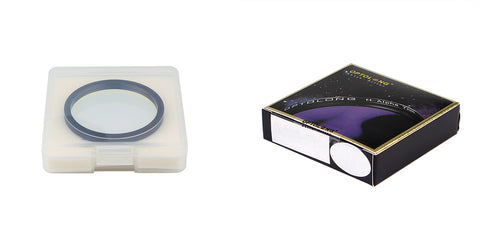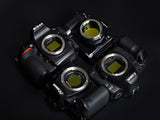Yes, our inventory is accurate!
![]() Qualifies Towards Free Ground Economy Shipping (CONUS Only) For Most Orders Of $149 Or More
Qualifies Towards Free Ground Economy Shipping (CONUS Only) For Most Orders Of $149 Or More
Description
The L-Pro (L-Professional) filter is the best light pollution filter with multi-bandpass filter which offers better color balance by maximizing the transmission band by selectively reducing the transmission of wavelengths of light pollutants. Specifically, those produced by artificial lighting, including mercury vapor lamps, both high & low pressure sodium vapor lights and the unwanted natural light caused by neutral oxygen emission in our atmosphere (i.e. skyglow).
The L-Pro filter enhances highly transparent main nebula emission lines at OIII (496nm and 500nm), H-beta (486nm), NII (654nm and 658nm). It enhances the contrast and details for both visual and photographic purposes in areas with heavy light pollution.
Which to Choose?
- L-Pro provides the broadest spectrum and most natural color. Suitable for imaging nebula, galaxy, star cluster, and comet targets.
- UHC is not as broad spectrum, less natural color, but will block more stray light and skyglow than the L-Pro. Best suited to nebula targets, not broad spectrum targets like galaxies, clusters, or comets.
- L-Enhance is a narrow tri-band filter. Best suited to capturing dim nebula targets. Will decrease brightness of surrounding stars, allowing for more faint detail.
If you plan to use the filter to image a wide range of targets, the L-Pro is the most versatile. The L-Enhance will provide the most faint detail on emission nebula, and the UHC is a budget option in the middle.
IMPORTANT Limitation of the EOS-R Filter
Due to the particularity of Canon R series micro-single optical path, aperture design and light incident Angle, slight dark angle interference will occur when using an interference filter such as the L-Pro clip filter for imaging.
There are two solutions to solve peripheral interference phenomenon: 1. Cut out the interference areas of picture. 2.By post processing via RAW (video tutorials: https://youtu.be/aDqCN5lu9PM).
Specifications
Technical Data
- Tpeak: T>90%
- Spectrum: 380-750nm
- Optical Density: Light pollution emission is blocked 90%
- Surface Quality: 60/40
- Transmitted Wavefront RMS: 1/4
- Parallelism (arcsec): 30s
Technical Data
- Schott substrate material
- Thickness 2.0mm
- Surface Quality: 60/40 (Refer to MIL-O-13830)
- Optically polished to ensure accurate 1/4 wavefront and <30 seconds parallelism over the both surfaces
Coating Parameter
- Non-cemented optical substrate coating
- Electron-beam gun evaporation with Ion-assisted deposition coating technology for durability and resistance to scratching, as well as stability on CWL (central wavelength); no deviation affected by temperature change
- Planetary rotation system offers precision and homogeneity of coatings ensuring high value on transmission of pass-band and Optical density of off-band
Filter Cell
- Ultra-thin filter cell minimizes vignetting by maximizing possible clear aperture (clear aperture is 26mm for 1.25”; 45mm for 2”)
- Aerometal Material
- Precise CNC Machining
- Sand Blasting Process
- Black Anodized Finish
- Extinction Treatment to Prevent Reflection
- Laser Engraving No Fading
Package
- Plastic PP Case
- Imported High Pressure EVA Case Lining
- Silver Cardboard Box
- High Density Sponge Carton Lining
Sizes
- Standard 1.25”
- Standard 2”
- Clip Filters for crop sensors and full frame sensors





